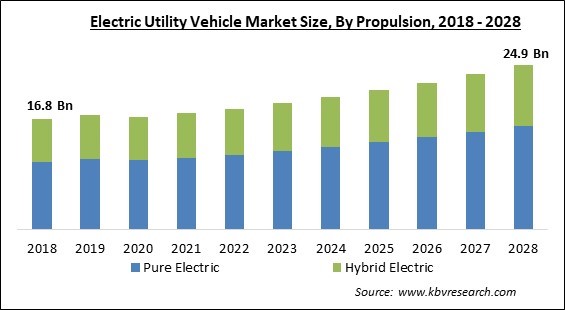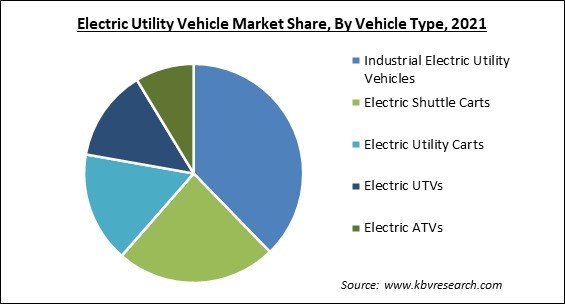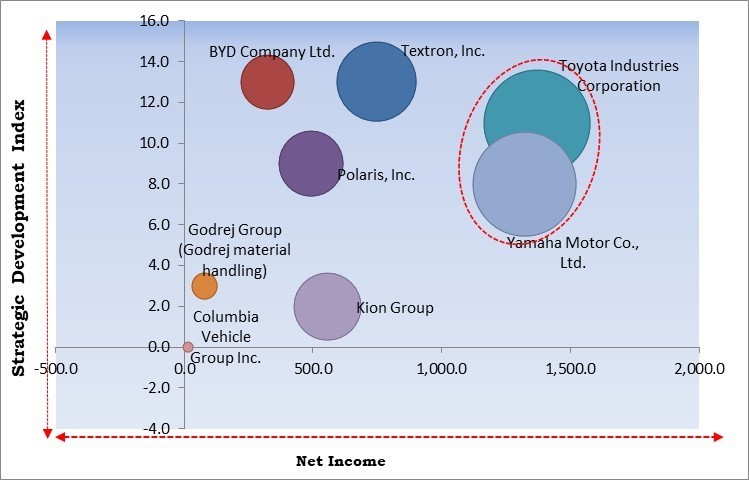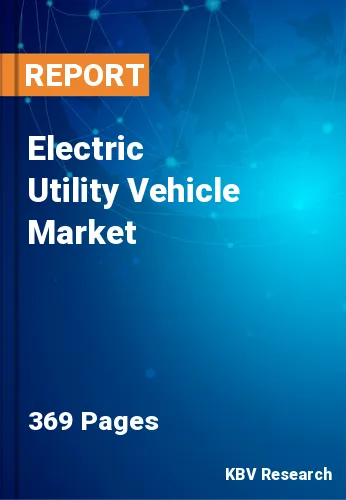The Global Electric Utility Vehicle Market size is expected to reach $24.9 billion by 2028, rising at a market growth of 5.3% CAGR during the forecast period.
Utility vehicle refers to a type of vehicle built to fulfill a certain duty and to traverse rugged terrain. Passenger and utility vehicles are used for commuting, with utility vehicles offering extra advantages over passenger cars, including increased passenger capacity, greater load-carrying capability, and enhanced safety and comfort, among others.

To meet operational needs, the majority of utility vehicles are designed with all-wheel drive (AWD) and four-wheel drive (4WD). Utility vehicles have a wide range of applications, including industrial activities, like the transportation of commodities, agricultural applications, and solutions for passenger transit. In recent years, electric utility cars have gained popularity due to their fuel-efficient operation and great noise reduction.
An electric vehicle is a type of vehicle that is operated by one or more electric motors. It can be fueled externally by a collector system or autonomously by a battery (sometimes charged with solar panels, or by converting fuel to electricity using fuel cells or a generator). EVs include surface and underwater watercraft, road and rail vehicles, electric airplanes, and electric spacecraft, among others.
EVs initially appeared a very long time ago, when electricity was one of the preferred ways for motor vehicle propulsion, offering a level of comfort and ease of operation that gasoline cars of the period could not match. In addition, internal combustion engines dominated the propulsion of automobiles and trucks, but electric power remained prevalent in trains as well as smaller vehicles of all sizes. Electric vehicles are either fueled by a collector system that collects electricity from charging station deployments or by self-charging equipment such as turbochargers, regenerative braking systems, and others.
Despite the fact that sales of electric vehicles were temporarily hampered by the pandemic, it is anticipated that the industry would therefore rebound with a higher growth rate than the previous year, due to the consistent increase in fuel prices and rising concerns about environmental pollution, as well as the provision of subsidies by various governments. The growth of the electric utility vehicle market was significantly hampered due to the pandemic; however, it is estimated to increase at a rapid pace as a result of the increasing efforts of governments all over the world to boost the automotive industry in their countries in addition to the growing adoption of electric vehicles due to their cost-effectiveness and environmental benefits.
Battery switching at the electric vehicle (EV) charging stations is the latest trend that eliminates the time electric utility vehicle users spend charging batteries. Although level 3 EV charging and ultra-fast charging can refuel an electric vehicle in 30–60 minutes and 15–30 minutes, respectively, they are not interoperable with electric utility vehicles. Consequently, battery changing is an excellent option for electric utility cars. In developed countries, various companies have deployed more than 300 battery switching stations in recent years and are significantly increasing their efforts in order to install more switching stations in the coming years.
The rising requirement to support the hub-and-spoke model in the e-commerce, automotive component manufacturing, consumer products, and electronics sectors is leading to an increase in the number of warehouses per country.in the coming years, the warehouse and fulfillment industry is anticipated to increase considerably, hence driving the demand for electric utility vehicles. Moreover, the increasing demand for industrial electric utility vehicles is anticipated to result from a rise in the number of warehouses. In turn, this will increase sales for the industrial segment of the electric utility vehicle market.
Users of utility vehicles often find it challenging to make the transition to more advanced electric versions of already existing models due to the additional high cost. Recent events in the market for electric utility vehicles have prompted original equipment manufacturers to increase the amount of money they invest in the development of products like these. This will result in an increase in the price of these vehicles because OEMs will want to recoup their investments. ATV model prices vary depending on feature requirements.

On the basis of Vehicle Type, the Electric Utility Vehicle Market is segmented into Electric ATVs, Electric UTVs, Electric Utility Carts, Electric Shuttle Carts, and Industrial Electric Utility Vehicles. In 2021, the industrial electric utility vehicles segment acquired the largest revenue share of the electric utility vehicle market. There is extensive use of electric vehicles in the industrial sector. The combination of their high levels of performance, resilience, and autonomy makes them the ideal alternative for industrial applications, allowing significant cost reductions.
Based on Battery Type, the Electric Utility Vehicle Market is segregated into Lead Acid, Lithium-Ion, and Others. In 2021, the lithium-ion segment registered the biggest revenue share of the electric utility vehicle market. A lithium-ion or Li-ion battery is a type of rechargeable battery that stores energy through the reversible reduction of lithium ions. It is the most common type of battery found in portable consumer devices and electric vehicles. It is also utilized extensively in grid-scale energy storage as well as military and aerospace applications.
By Drive Type, the Electric Utility Vehicle Market is categorized into 2WD, 4WD, and AWD. In 2021, the AWD segment acquired a significant revenue share of the electric utility vehicle market. AWD electric vehicles are not particularly common in the automotive sector. Conventional vehicles with all-wheel drive are popular and widely utilized. All-wheel drive electric vehicle (AWD electric vehicle) refers to an electric vehicle whose front as well as rear wheels are interconnected to the electric motor. At low loads, AWD electric vehicles help to conserve energy.
On the basis of Application, the Electric Utility Vehicle Market segregated into Commercial Transport, Recreation, Agriculture, Industrial, and Others. In 2021, the industrial segment registered the largest revenue share of the electric utility vehicle market. Produced exclusively for businesses and individuals that want a high degree of quality, dependability, and performance. Additionally, a utility vehicle's ability to accomplish several activities and operate in a wide variety of conditions is a defining trait. Alkè electric utility cars are created following the preceding philosophy: excellence without exception.
Based on seating capacity, the Electric Utility Vehicle Market is classified into 1-Seater, 2-Seater, and greater than 2-Seater. In 2021, the greater than 2-Seater recorded a substantial revenue share of the electric utility vehicle market. The rapid upsurge in the growth of this segment of the market is attributed to the increasing number of people going out for family adventure activities. This is a result of the rise in the disposable income of people across the world. Therefore, this factor is supporting the growth of this segment of the market.
By Propulsion, the Electric Utility Vehicle Market is bifurcated into Pure Electric and Hybrid Electric. In 2021, the Hybrid Electric segment garnered a significant revenue share of the electric utility vehicle market. The growth of this segment of the market is increasing significantly due to the growing demand for this type of vehicle throughout developing countries due to their fragile charging infrastructure. The charging infrastructure among developing and under-developed countries are capable of supporting fully-electric vehicles, which is bolstering the growth of this segment of the market.
| Report Attribute | Details |
|---|---|
| Market size value in 2021 | USD 17.6 Billion |
| Market size forecast in 2028 | USD 24.9 Billion |
| Base Year | 2021 |
| Historical Period | 2018 to 2020 |
| Forecast Period | 2022 to 2028 |
| Revenue Growth Rate | CAGR of 5.3% from 2022 to 2028 |
| Number of Pages | 369 |
| Number of Tables | 653 |
| Report coverage | Market Trends, Revenue Estimation and Forecast, Segmentation Analysis, Regional and Country Breakdown, Competitive Landscape, Companies Strategic Developments, Company Profiling |
| Segments covered | Vehicle Type, Propulsion, Application, Seating Capacity, Battery Type, Drive Type, Region |
| Country scope | US, Canada, Mexico, Germany, UK, France, Russia, Spain, Italy, China, Japan, India, South Korea, Singapore, Malaysia, Brazil, Argentina, UAE, Saudi Arabia, South Africa, Nigeria |
| Growth Drivers |
|
| Restraints |
|
Region-wise, the Electric Utility Vehicle Market is analyzed across North America, Europe, Asia-Pacific, and LAMEA. In 2021, North America accounted for the highest revenue share of the electric utility vehicle market. During the pandemic, the demand for electric ATVs/UTVs has increased dramatically in the region due to the rise in recreational activities, like camping, forest rides, hunting, etc. Moreover, there is also a significant prevalence of a number of market players in this region.
Free Valuable Insights: Global Electric Utility Vehicle Market size to reach USD 24.9 Billion by 2028

The major strategies followed by the market participants are Partnerships. Based on the Analysis presented in the Cardinal matrix; Yamaha Motor Co., Ltd. and Toyota Industries Corporation are the forerunners in the Electric Utility Vehicle Market. Companies such as Textron, Inc., Polaris, Inc., BYD Company Ltd. are some of the key innovators in Electric Utility Vehicle Market.
The market research report covers the analysis of key stake holders of the market. Key companies profiled in the report include Textron, Inc., Polaris, Inc., Yamaha Motor Co., Ltd., Toyota Industries Corporation, BYD Company Ltd., Kion Group, Godrej Group (Godrej Material Handling), Columbia Vehicle Group Inc. (Nordic Group of Companies, Ltd.), Waev, Inc., and Addax Motors N.V.
By Vehicle Type
By Propulsion
By Application
By Seating Capacity
By Battery Type
By Drive Type
By Geography
The global Electric Utility Vehicle Market size is expected to reach $24.9 billion by 2028.
An Increase In The Deployment Of Battery Switching Paradigm To Reduce Charging Time are driving the market in coming years, however, The Significant Cost Of EUVs And The Presence Of Ice Counterparts restraints the growth of the market.
Textron, Inc., Polaris, Inc., Yamaha Motor Co., Ltd., Toyota Industries Corporation, BYD Company Ltd., Kion Group, Godrej Group (Godrej Material Handling), Columbia Vehicle Group Inc. (Nordic Group of Companies, Ltd.), Waev, Inc., and Addax Motors N.V.
The 2-Seater segment acquired maximum revenue share in the Global Electric Utility Vehicle Market by Seating Capacity in 2021 thereby, achieving a market value of $14.5 billion by 2028.
The Pure Electric segment is leading the Global Electric Utility Vehicle Market by Propulsion in 2021 thereby, achieving a market value of $15.7 billion by 2028.
The North America market dominated the Global Electric Utility Vehicle Market by Region in 2021, and would continue to be a dominant market till 2028; thereby, achieving a market value of $8.7 billion by 2028.
Our team of dedicated experts can provide you with attractive expansion opportunities for your business.

